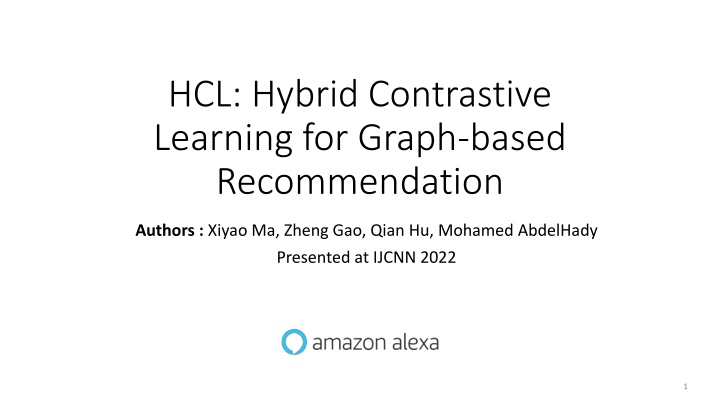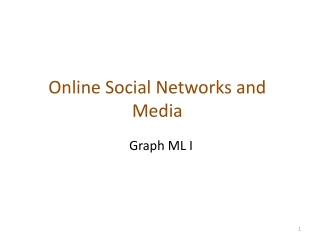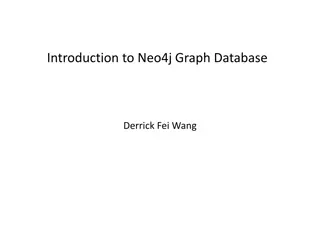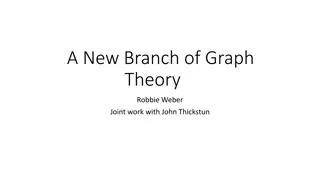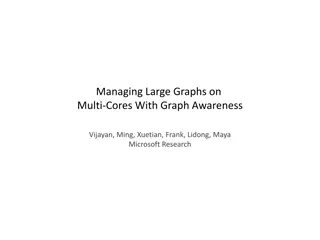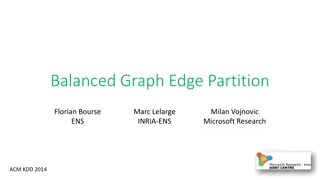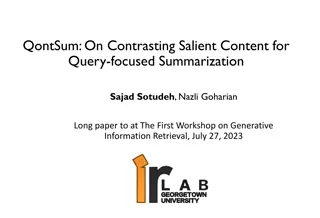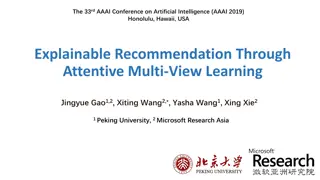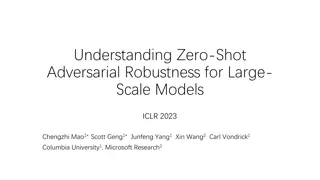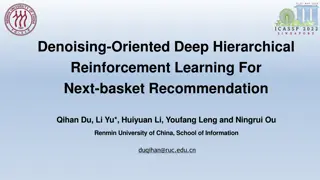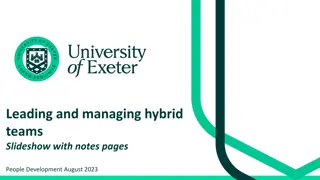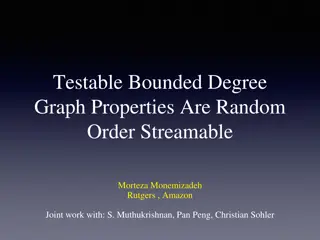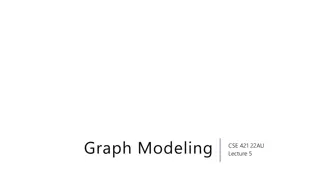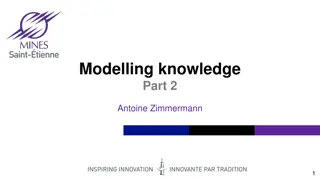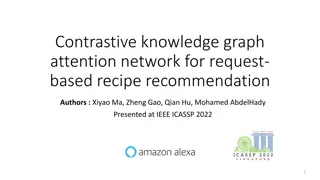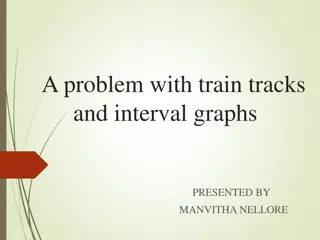Hybrid Contrastive Learning for Graph-based Recommendation
This study introduces Hybrid Contrastive Learning (HCL) for graph-based recommendation, combining unsupervised and supervised contrastive learning to enhance model generalization and robustness. The proposed method employs novel graph augmentation strategies to handle incomplete and noisy information in user-item graphs, outperforming state-of-the-art baselines in experiments.
Download Presentation

Please find below an Image/Link to download the presentation.
The content on the website is provided AS IS for your information and personal use only. It may not be sold, licensed, or shared on other websites without obtaining consent from the author.If you encounter any issues during the download, it is possible that the publisher has removed the file from their server.
You are allowed to download the files provided on this website for personal or commercial use, subject to the condition that they are used lawfully. All files are the property of their respective owners.
The content on the website is provided AS IS for your information and personal use only. It may not be sold, licensed, or shared on other websites without obtaining consent from the author.
E N D
Presentation Transcript
HCL: Hybrid Contrastive Learning for Graph-based Recommendation Authors : Xiyao Ma, Zheng Gao, Qian Hu, Mohamed AbdelHady Presented at IJCNN 2022 1
Introduction we propose Hybrid Contrastive Learning (HCL) for graph-based recommendation that integrates unsupervised and supervised contrastive learning. To summarize, the contributions of this work are three-folds: We identify the limitation of existing contrastive learning methods for recommendation and propose Hybrid Contrastive Learning. We generalize a permutational approach that performs hybrid contrastive learning across multiple views which are generated to convey incomplete and noisy information with respect to node embeddings and topology. Extensive experiments show the superiority of HCL regarding to model generalization and robustness over SOTA baselines on two public and one internal dataset. Alexa Confidential 2
Preliminary LightGCN is a strong graph collaborative filtering (GCF) baseline for recommendation that captures the high-order connectivity from the user-item bipartite graph, and the model is trained in a supervised learning paradigm. It is applied on the user-item bipartite graph to learn user and item representations by aggregating the representation of its direct neighbors N and with the defined graph convolution operations: Bayesian Personalized Ranking (BPR) finally assigns higher probability to observed interactions than its unobserved interactions: Alexa Confidential 3
Method: HCL Alexa Confidential 4
Method: HCL In general, the proposed HCL has three steps: We propose novel bipartite graph augmentation strategies by taking node embeddings and topology into consideration to generate different incomplete and noisy views for the input user- item graph. The proposed hybrid contrastive learning performs unsupervised and supervised contrastive learning on homogeneous nodes and observed user-item interactions, respectively. We conduct the hybrid contrastive learning among multiple views permutationally. Alexa Confidential 5
Method: Bipartite Graph Augmentation we propose four bipartite graph augmentation strategies to generate different graph views that contain incomplete and noisy information about node embedding and node topology to boost downstream contrastive learning, including node embedding dropout, edge dropout, edge moving and connecting similar homogeneous nodes. Alexa Confidential 6
Method: Hybrid Contrastive Learning Unsupervised Contrastive Learning: We pull together the different views of the same node and push apart those of different nodes. Supervised Contrastive Learning: We propose to encourage the consistency of the embeddings of the users and the interacted items by computing supervised contrastive learning (SCL) loss given the observed user-item interactions. We maximize agreement between user representation and item representation generated from different views Alexa Confidential 7
Method: Multi-view Permutation The total multi-view HCL loss is the summation of the HCL loss terms computed on every pair of graph views permutationally, and each HCL loss term is the summation of unsupervised contrastive learning losses on user and item nodes and supervised contrastive learning losses. We trained the model in the multi-task learning fashion with the final loss Alexa Confidential 8
Experiment: Settings Datasets We adopt two widely-used public datasets, Yelp2018 and Amazon-book, and one internal Alexa Recipe dataset to evaluate model performances across the experiments. Baselines We mainly adopt three categories of models as baselines for performance comparison: Non-GCF models (MF, NCF), GCF models (NGCF, LightGCN), and GCF model with contrastive learning (SGL). Alexa Confidential 9
Experiment: Comparison Results Model Performance Comparison on Public Datasets Model Relative Performance Comparison on Recipe Dataset with SGL. Ablation Study Alexa Confidential 10
Experiment: Parameter Tuning Effect of probability for bipartite graph augmentation Time (seconds) of training models for one epoch. Alexa Confidential 11
Experiment: Supplementary Studies Model performance with noise ratios. The bar represents the results in terms of Recall@20 and NDCG@20, respectively Visualization of users and items embeddings learnt by SGL and the proposed HCL. Alexa Confidential 12
Conclusion In this paper, we proposed a novel framework, named HCL, with three contributions to well exploit contrastive learning for graph-based recommendation: Bipartite graph augmentation operations from the perspectives of node embeddings and topology Hybrid contrastive learning that combines unsupervised and supervised contrastive learning Performing hybrid contrastive learning permutationally across multiple views. In the future, we aims to improve the model further by exploring negative sampling methods and curriculum learning that gradually incorporates more difficult negative samples. Alexa Confidential 13
Thanks! Q & A Alexa Confidential 14
